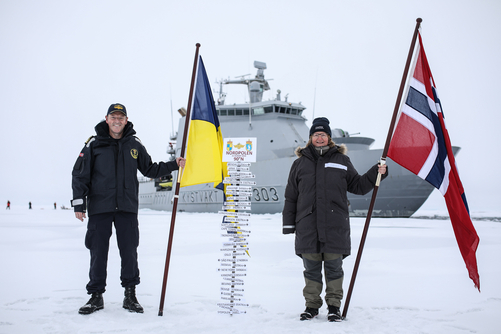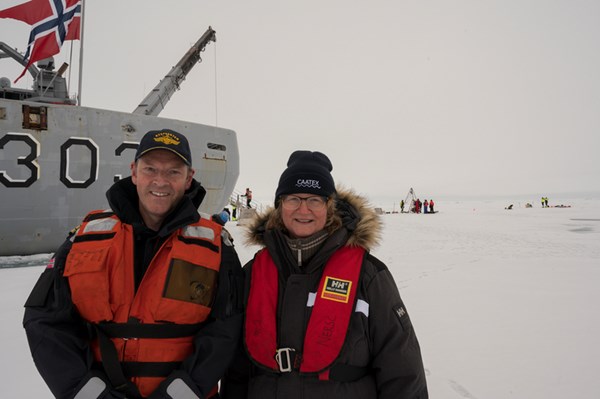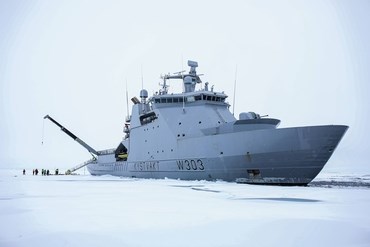
Commanding officer Geir-Martin Leinebø and Cruise leader Dr. Hanne Sagen at the North Pole 21. August 2019. Credit: Norwegian Coast Guard.
The internationally Coordinated Arctic Acoustic Thermometry Experiment (CAATEX) on board the Norwegian coast guard icebreaker KV Svalbard reached the North Pole yesterday. KV Svalbard reached the North Pole 125 years after Fridtjof Nansen tried to drift across the North Pole with his sailing vessel Fram. KV Svalbard has traversed the polar pack ice at speeds as high as 6 to 7 knots during much of the voyage through the ice to the pole point. Commanding officer Geir-Martin Leinebø commented,
"It is an incredible feeling to be at the 'top of the world'".
The goal was reached after one year of detailed planning, and combining the needed expertise and knowledge from different agencies. The CAATEX research cruise is led by Dr. Hanne Sagen from the Nansen Center and includes 18 scientists from nine Norwegian and international research institutions,
"I am very thankful and proud of the efforts and support from the Norwegian Coast Guard and the crew of KV Svalbard making the collection of unique scientific data from these remote parts of the Arctic Ocean."

Commanding officer Geir-Martin Leinebø and Cruise leader Dr. Hanne Sagen at the North Pole 21. August 2019. Credit: Norwegian Coast Guard.
Although the total ice extent in the Arctic Ocean this year has been close to the earlier record minimum from 2012, the ice conditions are more severe in the region north of Svalbard. Accordingly, KV Svalbard after leaving Longyearbyen on 14. August selected a more easterly sailing route, starting north of Franz Josef Land. The decision was made based on detailed analysis of the ice conditions during the spring and summer during previous years and this year. Daily updated satellite images from the Norwegian Ice Service in Tromsø and analysis made by Andreas Kjøl from the Coastal Directorate have made the sections of a sailing rout with less resistance from the pack ice. Navigation in the lead could accordingly be done at speeds as high as up to 6-7- knots (see map) and only 3.5 days sailing through the pack ice.
The CAATEX field investigations collects environmental data from the atmosphere, sea ice and ocean. An observational ice station is being conducted at the pole-point and deployment of an oceanographic rig will be done during the coming days. The main objective of CAATEX is to deploy several oceanographic rigs across the entire polar basin in order to use acoustic measurements to measure the water temperature in the whole water column under the ice. The rigs will perform their measurements during the coming 12 months.

The Norwegian KV Svalbard at the North Pole 21. August 2019. Credit: Norwegian Coast Guard.
KV Svalbard will deploy deep sea oceanographic moorings with a range (50 different sensors) of scientific instrumentation will be at four locations at depths of around 4000 meters during the next weeks. In addition, American and Canadian scientists will deploy three similar mooring in the Beaufort Sea during September. The core CAATEX instrumentations are acoustic transmitters and receivers that will measure the speed of the sound in the water between the moorings during the next year. This instrumentation has been designed in cooperation between the Nansen Center, the US Scripps Institution of Oceanography and Woods Hole Oceanographic Institution. The scientists will use these measurements to calculate the average water temperature between the pairs of moorings to be deployed across the entire Arctic Ocean. Similar acoustic experiments were done in 1994 and 1999 between Svalbard and the Beaufort Sea. During these five years the average water temperature decreased by almost 1 degree Celsius. These contemporary acoustic data from CAATEX in 2019-20 will provide new knowledge about the changes in the water temperature under the sea ice during the last 20 years, which is essential for if and how the ice is also meting from below. The research will contribute to improve the understanding of the processes for melting of sea ice to be used in improving the modelling of the changes observed in the Arctic sea ice cover.
CAATEX is coordinated by the Nansen Center, Bergen, Norway who participates with the cruiseleader and the scientists Drs. Espen Storheim and Florian Geyer. The national and international scientific partners include Norwegian Polar Institute, Scripps Institution of Oceanography, Woods Hole Oceanographic Institution, University of Texas-Austin, University of Bergen, NORCE, NTNU, Norwegian Meteorological Institute, Institute of Oceanology - Polish Academy of Sciences, and National Institute of Ocean Technology, India.
For more news about the INTAROS Summer Fieldwork Season 2019, stay tuned to our website and social media.
You can check out all the observing sites assessed by INTAROS in this interactive map.
22 August 2019